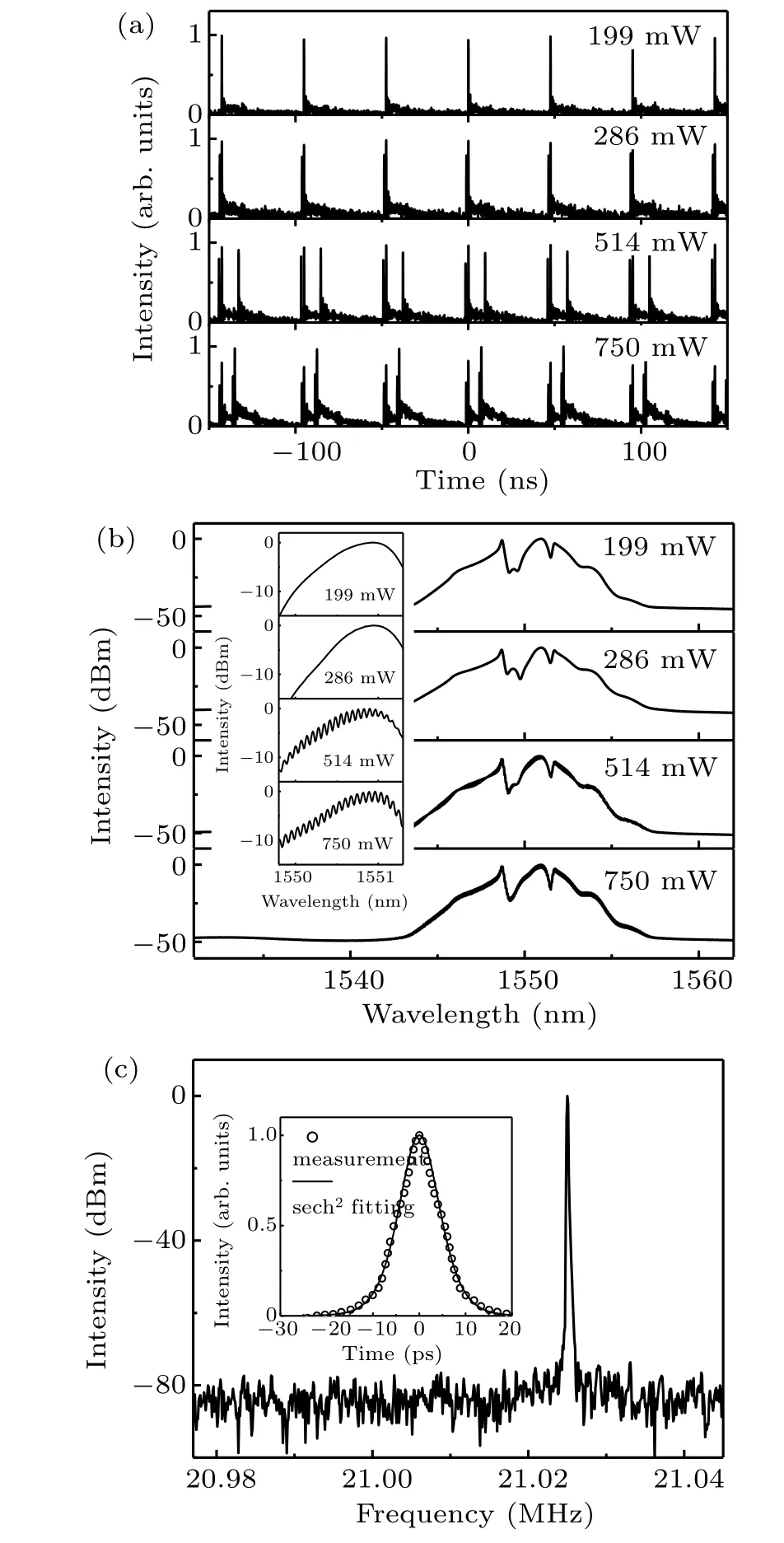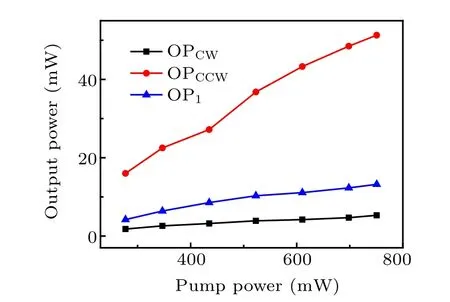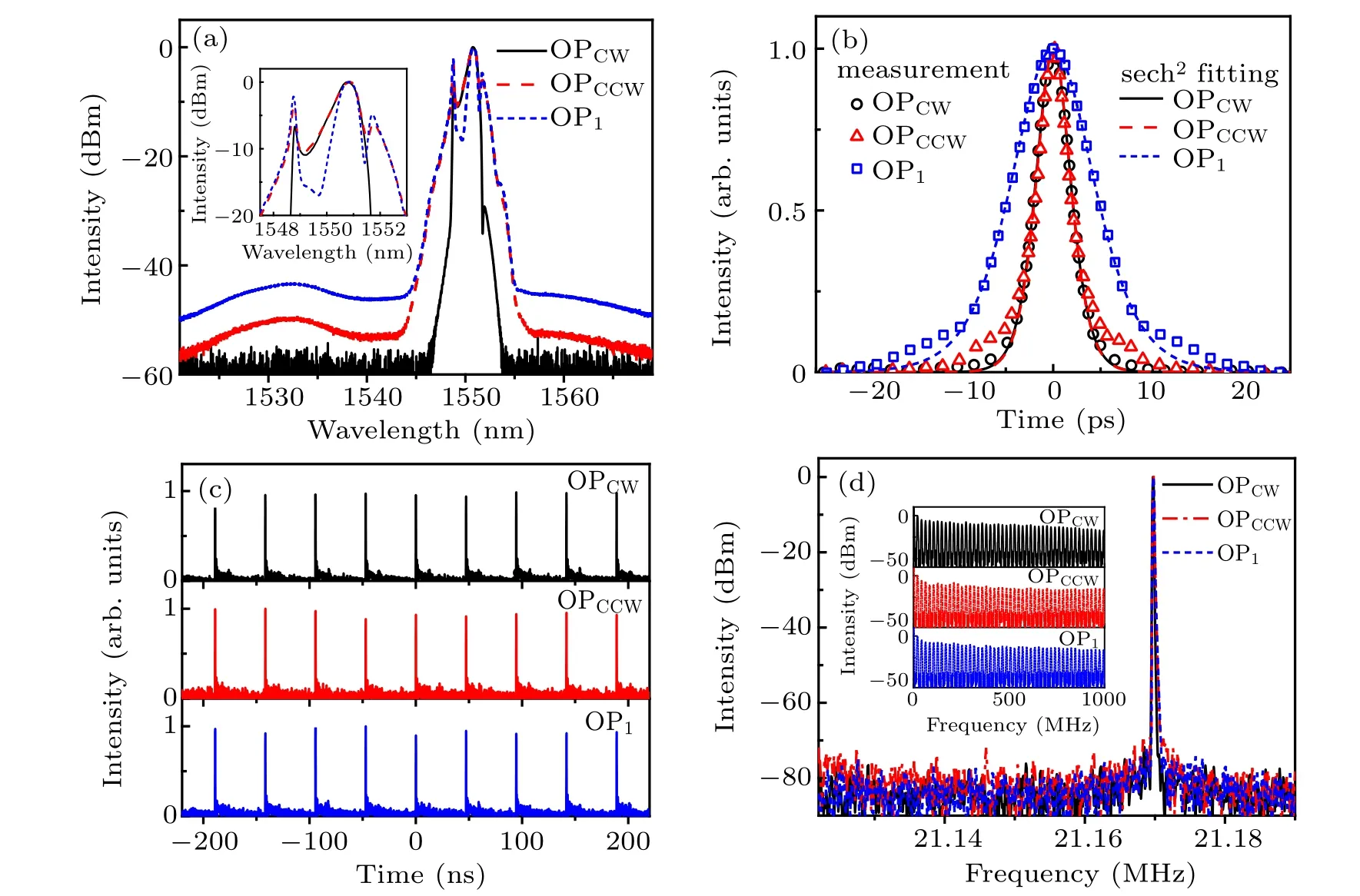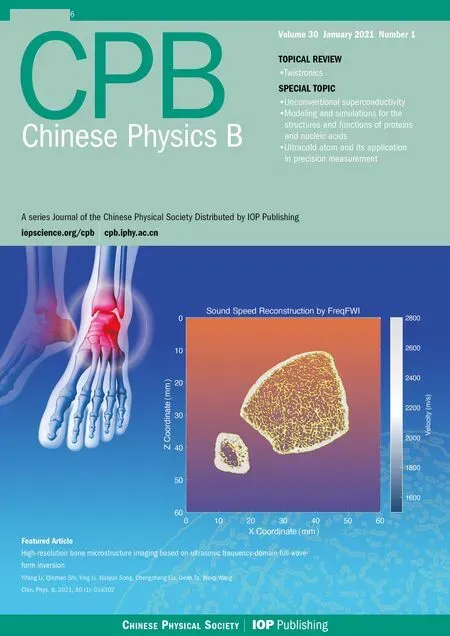Suppression of multi-pulse formation in all-polarization-maintaining figure-9 erbium-doped fiber mode-locked laser*
Jun-Kai Shi(石俊凯), Deng-Feng Dong(董登峰),2,†, Ying-Ling Pan(潘映伶), Guan-Nan Li(李冠楠),Yao Li(黎尧), Li-Tuo Liu(刘立拓), Xiao-Mei Chen(陈晓梅), and Wei-Hu Zhou(周维虎),2
1Optoelectronic Technology R&D Center,Institute of Microelectronics,Chinese Academy of Sciences,Beijing 100029,China
2University of Chinese Academy of Sciences,Beijing 100049,China
Keywords: figure-9 mode-locked fiber laser, nonlinear amplifying loop mirror, suppression of multi-pulse formation
1. Introduction
In recent years, passively mode-locked erbium-doped fiber (EDF) lasers cause a large number of concerns as compact, low-cost and robust ultrashort pulse sources at 1.5-μm band for various applications ranging from industrial purposes to fundamental researches, such as spectroscopy, precision metrology, optical communication, microscopy, and material processing,to name a few.[1–3]
To realize passively mode-locked operation, various material saturable absorbers (SAs) have been widely reported,such as semiconductor saturable absorption mirror,[4,5]single-walled carbon nanotube,[6,7]graphene,[8,9]topological insulators,[10,11]and black phosphorus.[12,13]The materialbased SAs often suffer thermal damage and oxidation, thus limiting the intracavity laser power and long-term stability of the fiber laser. The alternative techniques to solve the problems are the use of SAs based on fiber nonlinearity,such as nonlinear polarization evolution,[14,15]nonlinear optical loop mirror (NOLM),[16,17]nonlinear amplifying loop mirror(NALM),[18,19]Mamyshev oscillator,[20,21]and nonlinear multimode interference.[22,23]Among them, phase-biased NOLM and NALM would be favored because of fast recovery time, high damage threshold, good self-starting (SS) ability,low-cost, and the possibility of all-polarization-maintaining(PM)fiber implementation.
Moreover, passively mode-locked lasers operating with anomalous dispersion usually demonstrate multi-pulse operation under sufficient power. Different states are observed and investigated, such as bound-state solitons,[24,25]vector solitons,[26]soliton molecules,[27,28]soliton rains,[29]and dissipative soliton resonances.[30,31]But the fundamental modelocked operation is more favorable for certain practical applications because of its intrinsic low timing-jitter and amplitude fluctuation.[32,33]When the laser operates in multi-pulse regime, the intracavity pulse number can be reduced by simply lowering the pump power. But the output power also decreases.
In this work, we propose an architecture to suppress the multi-pulse formation in an all-PM figure-9 EDF laser under high pump power. A 2×2 fiber coupler is introduced into the phase biased NALM to extract part of intracavity laser power as a laser output,so the intracavity laser power is reduced.The intracavity nonlinear effect is mitigated which is conducive to avoiding the multi-pulse formation. With this architecture,the single pulse operation can be obtained with high pump power.The laser emits three pulse trains, which is convenient for some applications. Finally, the output power values of three ports are 5.3 mW,51.3 mW, and 13.2 mW, respectively. The repetition rate is 21.17 MHz,and the pulse widths are 2.8 ps,2.63 ps,and 6.66 ps,respectively.
2. Experimental setup
The schematic experimental setu p of the figure-9 laser is shown in Fig.1. A 2×2 PM fiber optical coupler(OC1)with a splitting ratio of 50%is used at the junction of the proposed architecture. The NALM is formed with a piece of 1-m PM EDF (PM-ESF-7/125, Nufern). The gain fiber has a mode field diameter of 8.8 μm, a core absorption of 55 dB/m at a wavelength of 1530 nm and a group velocity dispersion of-0.02 ps2/m. A laser diode (LD) with a pump wavelength and maximum output power of 976 nm and 800 mW is employed to pump the EDF with a standard PM 976/1550 nm wavelength division multiplexer (WDM1), and the residual pump laser is extracted out of the cavity by WDM2. The linear arm of the figure-9 cavity consists of a high reflector(HR)and a 2-nm bandpass filter (BPF) with a center wavelength of 1550 nm. The BPF works to block the longer-wavelength(Raman self-frequency shift)and reduce the intracavity pulse duration,so the intracavity pulse can rapidly evolve back over the next roundtrip. The laser transmitting through the NALM is utilized as an output (OP1). A home-made non-reciprocal phase shifter is inserted into the NALM.The phase shifter consists of a 45◦Faraday rotator,two quarter waveplates(QWPs),and a half waveplate(HWP).Without the non-reciprocal phase shifter, the reflection of NALM for low intensity is close to a maximum value and the NALM does not offer any intensity dependence. In such a condition, ultrahigh intracavity power or ultralong fiber loop is necessary to initiate modelocking. With the phase shifter, the NALM offers obviously intensity dependence for low intensity, and SS operation can be achieved easily. To suppress the multi-pulse formation,OC2is introduced and the laser beams coupled out of the cavity by OC2are used as a clockwise output (OPCW) and counter-clockwise output (OPCCW). The group velocity dispersion of the passive PM fiber is-0.022 ps2/m,and the net cavity dispersion is estimated as-0.21 ps2. The output laser is measured by a digital storage oscilloscope (KEYSIGHT,DSO9254A), and a radio-frequency analyzer (KEYSIGHT,N9010A)together with a 1-GHz photo detector. The spectrum is recorded by an optical spectrum analyzer (YOKOGAWA,AQ6370D),and the pulse profile is measured by a commercial autocorrelator(APE PulseCheck).

Fig.1. Schematic diagram of experimental setup, LD:laser diode; WDM:wavelength division multiplexer; OC: optical coupler; EDF: erbium-doped fiber; BPF: bandpass filter; PS: phase shifter; HR: high reflector; OP: output; OPCW: clockwise output; OPCCW: counter-clockwise output; COL:collimator;FR:Faraday rotator;QWP:quarter waveplate;HWP:half waveplate.
3. Results and discussion

Fig.2. Output characteristics of figure-9 mode-locked EDF laser without OC2 showing (a) pulse trains and (b) mode-locked output spectra(inset: details around central wavelength) with different pump power values, (c) radio-frequency spectrum (inset: autocorrelation trace) of single pulse output.
In our experiment, the OC2is replaced by a piece of passive PM fiber with almost the same length firstly. The pump power is set to be an available maximum of 750 mW,and the SS mode-locked operation is realized by finely adjusting the waveplates in the phase shifter, however, in the multi-pulse regime. The pulse trains and optical spectra for different pump power values are shown in Figs.2(a)and 2(b).The laser operates in four-pulse regime with pump power of 750 mW, and the output power is 30 mW. As shown in Fig. 2(b), there are some dips in the spectrum which are induced by the interference of the counter-propagated pulses at the OP1port. The inset of Fig.2(b)shows the spectral details with a resolution of 0.01 nm around the central wavelength.The spectrum is modulated with a period of 0.07 nm which proves the operation of bound state solitons. As the pump power decreases, the laser turns into three-, two- and singlepulse operations at the pump power values of 514, 289, and 199 mW,respectively,and the interference pattern of spectrum finally vanishes. The temporal traces of mode-locked pulses show up obvious noise on the substrates, which is mainly attributed to the intrinsic noise of oscilloscope and photo detector. Figure 2(c) shows the radio-frequency (RF) spectrum of single-pulse output with a resolution bandwidth(RBW)of 100 Hz, and the inset shows the autocorrelation trace. The repetition rate is 21.025 MHz, which accords well with the periods of the pulse trains. The full width at half-maximum(FWHM) of autocorrelation trace is 10.96 ps, and the corresponding pulse width is estimated at 7.12 ps under a sech2-shape assumption. The signal-to-noise ratio(SNR)of 73.6 dB indicates the excellent stability of the soliton mode-locked opetation. The single-pulse operation can be realized by reducing the pump power,but it is inconvenient for use,and the output power is as low as 6 mW.
To overcome the drawbacks mentioned above, an OC2is inserted into the NALM. The OC2works as both power attenuator and bidirectional output coupler. Part of the intracavity laser power is extracted as a laser output, and the intracavity nonlinear effect is mitigated, which is conducive to avoiding the multi-pulse formation. In the meantime, the loss-imbalance induced by OC2is helpful in improving the SS ability.[34]The dependence of output couple ratio of OC2on the mode-locking state is investigated to confirm the significance of the proposed architecture, and the mode-locking output characteristics versus 750-mW pump power are shown in Fig.3. The repetition rate remains around 21 MHz with different output ratios as shown in Fig.3(a),and the SNR remains above 70 dB.When the output couple ratio is increased from 0% to 60%, the number of circulating pulses gradually decreases and single pulse operation finally is achieved as shown in Fig. 3(b). It can be understood as the higher output couple ratio leading to lower intracavity power and consequent weaker self-phase modulation, which is conducive to avoiding wave-breaking. The result shows that the SS single pulse operation can be realized easily with an output ratio of 50%or greater. Figure 3(c) shows that the mode-locking threshold and loss of locking threshold exponentially increase as the output ratio increases,which is attributed to larger cavity loss.The mode-locking threshold with an output ratio of 70% or greater is higher than the available maximum pump power,so the mode-locking cannot be achieved. Figure 3(d) shows the output power values of three ports for different output couple ratios. The power values of OPCWand OPCCWincrease with the increase of output couple ratio,especially for OPCCWwhich increases from 0 mW to 51 mW with the output couple ratio increasing from 0%to 60%. Although the power of OP1decreases,the total output power increases significantly.

Fig.3. Experimentally observed mode-locked(a)RF spectra,(b)intracavity pulse number,(c)mode-locking threshold and lose locking threshold,(d)output power values versus output couple ratio under pump power of 750 mW for different OP cases.

Fig. 4. Plots of output power versus pump power with output couple ratio of 60%for different OP cases.
With an output couple ratio of 60%, the figure-9 modelocked EDF laser works in single-pulse state under the pump power of 750 mW.The output power values of three ports for different pump power values are shown in Fig. 4. The maximum output power values of OPCW, OPCCW, and OP1are 5.3 mW,51.3 mW,and 13.2 mW,respectively. The total single pulse output power is 69.8 mW, which is more than 10 times the result without OC2. The total slope efficiency is about 10.1%. Figures 5(a)and 5(b)present the optical spectra and autocorrelation traces of the pulses emitted from OPCW,OPCCW, and OP1, and the inset of Fig. 5(a) shows the spectral details around central wavelength. The FWHMs of autocorrelation traces are 4.32 ps, 4.05 ps, and 10.25ps, and the pulse durations are estimated at 2.8 ps, 2.63 ps, and 6.66 ps with a sech2-shape assumption, respectively. The 3-dB spectral bandwidths are 2.58 nm, 3.24 nm, and 3.33 nm, with the corresponding time-bandwidth products of 0.903, 1.063, and 2.765, respectively. The OPCWpulse can be considered as an NALM input pulse, because it exits shortly after entering the fiber loop. The spectral sideband of OPCWis removed by the BPF. The OPCCWpulse can be considered as an NALM output pulse, the distortion is caused by nonlinear chirp accumulation during amplification and transmission in the passive fiber. The OP1pulse can be considered as the superposition of CW and CCW output pulses of the NALM.These two pulses experience passive fiber,phase shifter and gain fiber in the opposite order and direction. As a consequence,there is a phase delay difference and a slightly time delay between the counter-propagating pulses, and OP1pulse duration is much larger than the other output pulses. The pulse trains are shown in Fig.5(c). The period of the pulse trains is about 47.24 ns,which accords well with the cavity roundtrip time and confirms the mode-locked operation. The RF spectra around the fundamental repetition rate are measured with an RBW of 100 Hz as shown in Fig. 5(d), and the RF spectra measured in a range of 1 GHz are shown in the inset of Fig. 5(d). The fundamental repetition rate is 21.17 MHz,which matches with the period of the pulse trains. The SNRs of 72 dB demonstrate the good stability of the soliton mode-locked operation.The experimental results indicate that the proposed architecture can effectively suppress multi-pulse formation in a figure-9 ultrafast laser,and significantly improve the single pulse output power.

Fig. 5. (a) Output spectra (inset: spectra in details), (b) autocorrelation traces, (c) pulse trains, and (d) RF spectra over a 70-kHz span with 100-Hz resolution(inset: RF spectra in large domain)with output couple ratio of 60%and pump power of 750 mW.
4. Conclusions
In this work,an all-PM figure-9 EDF laser is experimentally investigated. A bidirectional OC is introduced into the NALM to suppress multiple pulse formation and improve the output power of single pulse train. The SS mode-locked operation is realized easily. The influence of output ratio of OC2on the output characteristics is experimentally investigated,and the pulse evolution in the figure-9 cavity is also studied.Finally, the output power values of three ports are 5.3 mW,51.3 mW, and 13.2 mW, respectively. The total single pulse output power is 69.8 mW,which is more than 10 times the result without OC2.This setup provides three pulse trains,which can be useful for applications.
- Chinese Physics B的其它文章
- Numerical simulation on ionic wind in circular channels*
- Interaction properties of solitons for a couple of nonlinear evolution equations
- Enhancement of multiatom non-classical correlations and quantum state transfer in atom–cavity–fiber system*
- Protein–protein docking with interface residue restraints*
- Effect of interaction between loop bases and ions on stability of G-quadruplex DNA*
- Retrieval of multiple scattering contrast from x-ray analyzer-based imaging*

